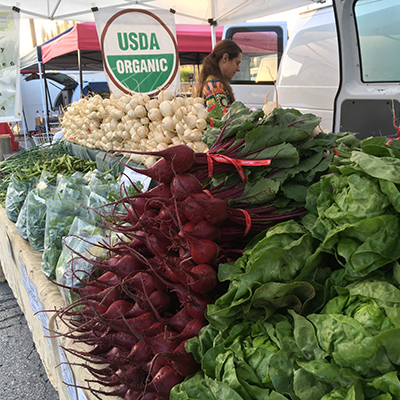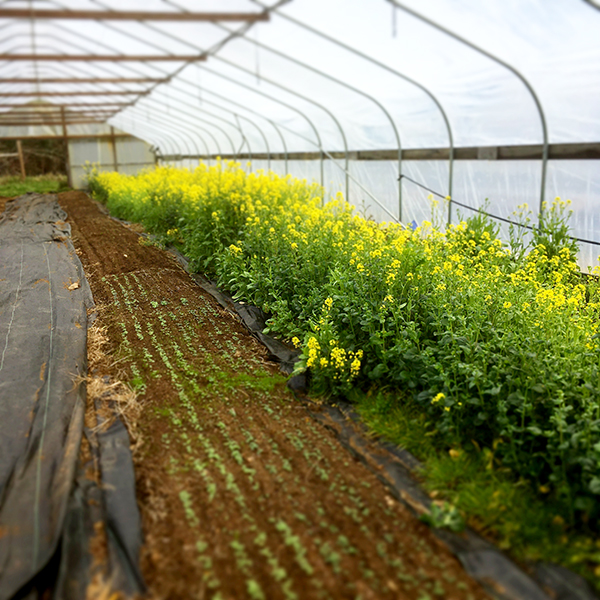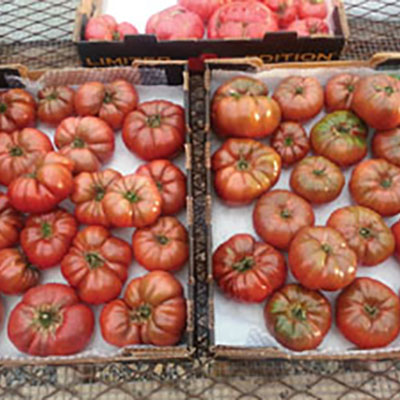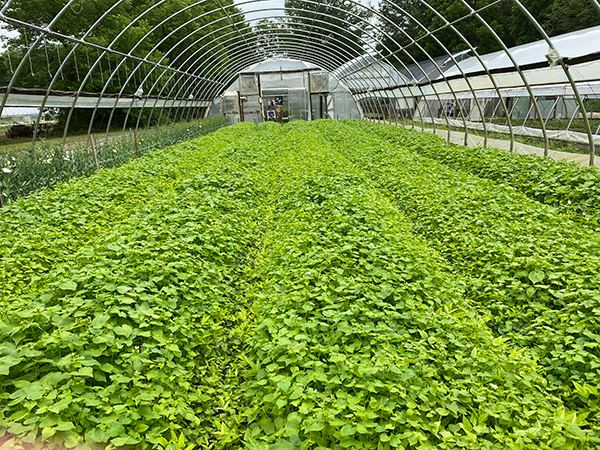This article was originally published in the November 2017 issue of the Growing For Market Magazine.
Dahlias were our number one crop this year, even beating out lisianthus and ranunculus by a landslide. We have tried many different methods of growing them, and these are the solutions we’ve come up with. I’m sure there are still better ways, and if you know of any, definitely send them our way! This year we planted 7,000 dahlias and plan to plant even more next year as we increase our growing space. Let’s just start at the beginning with planting and work our way through the whole process.
Planting
Dahlias grow in clumps of multiple tubers radiating out from the original mother tuber. To prepare for planting, we make sure all the clumps are divided down to a single tuber and have a viable eye. That way we know the beds will be full in the field. We plant our dahlias two rows per bed, using two large sweeps on the back of our cultivating tractor to make the trenches. In the trenches, we plant them lengthwise every 12”.
This is closer than most gardening sources tell you to plant them, but we leave really long stems on our dahlias, cutting off a lot of plant material in the process. Cutting so much off opens up the otherwise dense canopy. Hobby growers will usually cut smaller stems and end up with a much larger plant.

Cultivating
Dahlias are in the ground for a long time, so we’ve tried many different methods for weed control, and here’s what we’ve landed on this year. The trenches we dig for the dahlias to be planted in are set to the same spacing that fits our mechanical cultivators. We start off with the tine weeder and can run that over until the sprouts of the tubers are about 2” tall. Then we switch to the cultivating sweeps that are set to two-row spacing (this is a different belly mounted cultivating tractor than the one we use for four-row spacing, but a similar idea). We run the Farmall over the rows on a weekly basis until the plants are too big, and then put down a thick layer of straw. Our hope with this method is to kill as many of the little weeds at white thread stage as we can, and then put down drip irrigation and the straw so nothing else germinates.
It used to be that we would hoe as much as we could, and then it would take the whole crew multiple days to hand weed the dahlia patch, and we’d have to do that at least three times per season. This year we only weeded it once by hand, and it was a lot less handwork. After we stop cultivating, we use one layer of Hortonova netting for support as the plants get taller. The bushy plants get really heavy, so we make sure they have lots of support.
Other methods that may work for you are: woven landscape fabric and planting plugs instead of tubers (or having large enough holes for the tubers to grow through), or flame weeding the patch until the tubers have sprouted (which we have considered adding to the mix). We’ve tried the woven landscape fabric in the walkways, but we still had a lot of weed pressure, had to weed the edges, and then rip it up in the fall before tuber digging. For more on transitioning away from plastic, see the article “Flower farming without plastic” in the August 2016 GFM.

Nutrients and pests
We’ve found that dahlias need a lot of nutrients since they are in the ground for so long and produce so many blooms. This year for the first time we were able to plant the dahlias on land we had rested with cover crops that included daikons the previous year. They seemed to enjoy the room for their roots/tubers to grow, so I am excited to see how that affected tuber production. We get crushed leaves from the local municipality that we applied directly to the field, as well as the amendments our soil tests called for. Every two weeks we fertigate through the drip irrigation with a homemade mix of seaweed, fish emulsion, calcium, magnesium and molasses. This mix is also applied using our backpack sprayer to foliar feed four times a season.
Our biggest dahlia pests are cucumber beetles, which are difficult to deal with since they love all the crevices dahlias have to hide in. We use organza bags on them to protect the blooms as they open. Each day that we harvest, we leave the bags on until we bring the dahlias up to the barn and then unbagging is part of the bunching process. At the end of each day, we take the bags back out to the field and bag the next biggest buds in order of dahlia importance and what gets hit the most by the beetles: cafes, other dinnerplates, whites, chocolates, and then whatever else is left after that gets last priority. Orange seems to be their last choice, but if you have a big influx of them, then they’ll eat all the colors.

Cutting
People always ask me how we get such long stems and the answer is just to cut long stems. It sounds crazy, but if you cut them hard from the beginning the plant will branch out closer to the base, giving you longer stems to cut. This is hard for people who are just starting to cut dahlias because they feel like they are taking too much, but it really leads to lots of nice, long straight stems for the rest of the season. Some growers will pinch the plants back once they sprout to get the branching started early, but we don’t typically have time early in the season to do that. So ours get pinched when the first cut happens on the plant. All our dahlias are sold in five-stem bunches which are processed in the barn. We don’t bunch anything in the field so we have another round of grading.
Digging and storage
Before it frosts we go through and make sure the rows are mapped correctly and then use flagging tape at the base of any rogue plants. After frost, we remove all the nets and posts, and then use a weed whacker or hedge trimmer to cut the plants down. Then, to loosen the tubers, we use an undercutter. We had it fabricated for our three-point hitch, just like the ones vegetable growers use to loosen root vegetables. We put the tubers in bulb crates and then load them onto a pallet that goes into the barn and cures for a few weeks before going in the cooler. We divide the tubers throughout the winter and then put them in peat that we mist before storage. We used to put each crate into a lawn and garden bag, but now we have quantities such that we put the divided tubers onto a pallet and wrap with packaging shrink wrap before putting them into the cooler. We leave the fan on the AC that we typically use as a cooler, and put a heat plug into the cooler, making a space heater kick on if it gets down to 34 degrees. That way it doesn’t freeze in there.

Colors and cultivars
What types of dahlias you choose will really depend on the market in your area and your sales outlets. We grow mainly from tubers, although we do some of our own cuttings and for the 2018 season plan to buy some plugs in to compare production (and also to increase stock without having to dig any more tubers). The Karma series are available as plugs through Gloeckner, which we had previously stayed away from because they were more open-faced flat varieties, and I’m not typically into the decorative types. We had a Karma Naomi that popped up and with the high demand for burgundy dahlias we had, I think that will be a good variety. Again, this is totally based on your market, but typically what we want are mainly ball dahlias because they last the longest and hold up on a grocery sales floor in seasonal bunches or mixed bouquets.
Our dinnerplate dahlias are mainly sold to florists, designers, and the wholesalers. People may buy some at market, but when they only last a few days, they don’t tend to perceive the same value, especially when they are used to other flowers lasting much longer. We even decided not to put dinnerplates in bouquets, so the ones that didn’t sell to florists just became flowers for our employees to take home and enjoy. Of course, the most popular dinnerplate is the Café au Lait, whose blooms range from champagne to a pinky lavender. We sell these mainly as a mix unless a florist specifically requests Café pink or Café cream. Other popular ones we grow are Ben Huston, which I project will become more popular since it has rusty, mustard and bronze tones that are on trend right now. Ones we grew that we thought were great but don’t sell a ton of are: Breakout, Shiloh Noelle, and Otto’s Thrill. It took someone having a wedding that was specifically that color to want those varieties.
Each year we are testing out new cultivars of dahlias to see if they are good enough for our cut flower production. Since we sell dahlia tubers, we want to grow a cultivar first before we provide it to folks, to make sure it is exactly what a flower farmer is looking for. We choose not to grow yellow dahlias because the cucumber beetle pressure is so bad. Also most yellows are more a highlighter yellow than a golden fall tone, which is not my favorite. I do like Suncrest a lot though, and it’s a great productive plant, and plan to try Karma Gold next year.

I’m not sure why, but the oranges seem to be the most productive (Maarn and Sylvie’s Queen especially). This year it was all about the burgundy dahlia in our area. For those from our selection we were able to use Cornell, Karma Chocolate, Jessie G, Keisha Lea, and Ken’s Choice. We’ll be adding more varieties to this dark flower selection since that is one of my favorites (Spartacus, Jowey Mirella, and Karma Naomi are in the running for next year also).
We tried this year to give the florists all the dahlia names so they could learn them, but it made it a little more difficult to fill orders allowing them to be that specific. So instead, we sold them mainly by color groups unless there was a name they already knew or a color that was difficult to describe (like Suncrest, Jowey Winnie, and Café au Lait). Jowey Winnie is probably my favorite as far as dahlia shape goes, with the symmetry of the tubular petals being so perfect. It’s a peachy lavender color which sort of changes throughout the season. Other cultivars with that style of petal structure: Hy Suntan- burnt orange, Dorothy- my favorite white one, Downham Royal- purple. We are always on the lookout for more cultivars that would be great additions to the repertoire, and look forward to continuing to discover ones that will give us the best stem length, vase life, and productivity so they can be most profitable.

Gretel and Steve Adams operate Sunny Meadows Flower Farm in Columbus, OH. They will have dahlia tubers and tuberose for sale at their website: www.plantdahlias.com. If you are interested in knowing when they are available, join the mailing list and they will announce when this year’s dahlia listing is posted. They’ll provide tubers of only the finest varieties for cut flowers, check out the selection!




 Northern California is beautiful in its own unique way in August, with dried out hills covered in brown grass and widely branched, stately live oaks sprinkled around, and a
Northern California is beautiful in its own unique way in August, with dried out hills covered in brown grass and widely branched, stately live oaks sprinkled around, and a

 If you’ve been a subscriber to Growing For Market (or even if you haven’t), you’re probably familiar with the many advantages of no-till agriculture. No-till methods can reduce a farm’s carbon footprint, promote complex soil biology, and preserve and build organic matter.
If you’ve been a subscriber to Growing For Market (or even if you haven’t), you’re probably familiar with the many advantages of no-till agriculture. No-till methods can reduce a farm’s carbon footprint, promote complex soil biology, and preserve and build organic matter.
 Until two years ago I was germinating all seedlings in greenhouses using almost exclusively bottom heat from electric heat mats. At my current farm we only had space for about 8-10 trays on our two mats and we definitely noticed differences in the germination (and presumably the heat the mats were providing) on the edges of our trays.
Until two years ago I was germinating all seedlings in greenhouses using almost exclusively bottom heat from electric heat mats. At my current farm we only had space for about 8-10 trays on our two mats and we definitely noticed differences in the germination (and presumably the heat the mats were providing) on the edges of our trays.
 Here's a system to track all those details
Here's a system to track all those details







 Over the last 10 years, there has been a lot of information coming out pertaining to growing veggies in soil in greenhouses. We wanted to share some of what we’ve learned over the past 13 years growing flowers under plastic and touch on some new approaches we’ve implemented since we last wrote about greenhouse growing (see our GFM articles in November 2014, November 2015, and April 2018).
Over the last 10 years, there has been a lot of information coming out pertaining to growing veggies in soil in greenhouses. We wanted to share some of what we’ve learned over the past 13 years growing flowers under plastic and touch on some new approaches we’ve implemented since we last wrote about greenhouse growing (see our GFM articles in November 2014, November 2015, and April 2018).
 Farming in any location is challenging. Imagine the challenge of growing crops at latitude 54.5° where winter temperatures hit minus 40° Celsius (minus 40° Fahrenheit) and a mere 100-day growing season can be abbreviated with a large dump of snow at the beginning of September. Meanwhile during the spring, Chinook winds blow and the high latitude’s strong sun alters flowers’ growing cycles.
Farming in any location is challenging. Imagine the challenge of growing crops at latitude 54.5° where winter temperatures hit minus 40° Celsius (minus 40° Fahrenheit) and a mere 100-day growing season can be abbreviated with a large dump of snow at the beginning of September. Meanwhile during the spring, Chinook winds blow and the high latitude’s strong sun alters flowers’ growing cycles. 